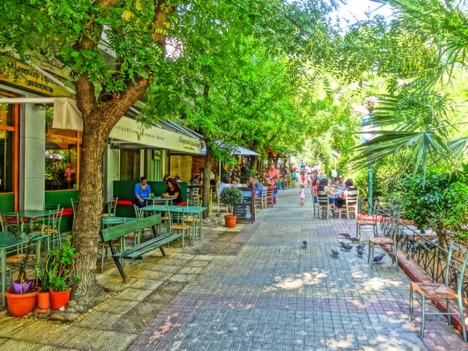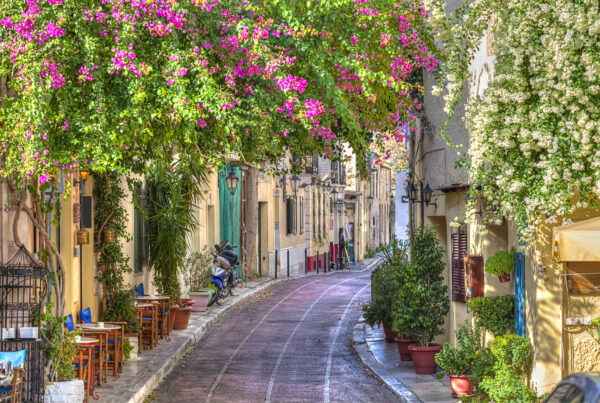Kolonaki is a charming district built on the slopes of Lycabettus, the highest hill in Athens. Kolonaki is known as the posh area of downtown Athens, with luxurious boutiques, fine dining restaurants, upscale taverns, chic cafes, art galleries, embassies, museums and the accompanying elegant people. The distinguished character of this neighborhood is derived from the mix of neoclassical and modern architecture, but what makes Kolonaki truly unique is its vibrancy. Full of life, day or night, people come to Kolonaki for their shopping trips, lunch breaks, business meetings, aperitivo with friends, or to enjoy cocktails or dancing in the clubs.

Kolonaki may be wealthy, chic and fashionable, but its origin is much more humble. The first inhabitants settled in Kolonaki during Ottoman rule, selecting the area as grazing land because it offered the closest feeling to the mountain villages from which they came.
The influx of wealth to Kolonaki began in the 19th century, when the construction of the Royal Palace (now the Parliament building) was begun nearby. Many prominent figures at the time started to settle in Kolonaki in order to be in close proximity to the aristocracy.
Kolonaki is a must visit if you love shopping, museums or just want to spend a relaxing day people watching whilst sipping a Greek or international coffee.

Have a cultural day with museum hopping
1) The Benaki Museum of Greek Culture, established and endowed in 1930, is housed in one of the most beautiful neoclassical-style buildings in Athens. It was converted into a museum in order to shelter the collections of Antonis Benakis and was donated to the Greek nation by himself and his three sisters. The museum’s extensive collection features relics and objects from 3000 BC up until the beginning of the twentieth century, displayed in a chronological order throughout the four floors. The Benaki Museum features Byzantine Art; Prehistoric Art, Ancient and Roman Art, Chinese Art; Post-Byzantine and Neo-Hellenic Art, as well as a collection of paintings spanning several others. www.benaki.org/


2) The Museum of Cycladic arts is housed in two separate buildings, which are connected by a glass-roofed corridor: the Main Building houses the permanent collections and the New Wing, and the Stathatos Mansion next door, houses the temporary exhibitions. The museum was inaugurated in 1986 and houses one of the most complete private collections of Cycladic art worldwide. It features a 5,000-year-old artwork collection with high quality figurine of marble, vases, tools, weapons and pottery from all phases of the distinctive Cycladic Island culture that flourished in the central Aegean during the Early Bronze Age (third millennium BC). The Museum of Cycladic Art is not only one of the best-known museums in Athens, but it’s also one of the most interesting. https://cycladic.gr/en


Lycabettus Hill: A Truly panoramic view of Athens
The main reason to hike to the top of Lycabettus Hill is for the (arguably) best view in downtown Athens; an excellent motive in itself. The view from the top is best enjoyed at sunset, whilst waiting for the lights of the Acropolis, Temple of Olympian Zeus, Panathenaic Stadium and Ancient Agora to turn on and illuminate the night sky. At the top there is the tiny, 19th century Chapel of St. George, which has some moderately interesting frescos but frankly is more interesting from the outside than the inside, a restaurant (Orizontes), as well as a wonderful outdoor café (Prasini Tenta https://prasinitenta.gr/ ). There are several different ways to climb to the viewing platform and church on top; by foot, by car (ending at Prasini Tenta Café) or by funicular (Lycabettus’s unique cable car with starting point at Aristippou 1 Street), which is a three-minute ride that passes through a steep tunnel.


Dexameni square; A sneak peak into an ancient reservoir, a picturesque café bar and open air cinema.
Hadrian’s Reservoir was built between 134-140 AD, and for hundreds of years cooled and watered the Athenians. Unfortunately, it is not currently open to visitors, but you can catch a glimpse of its interior structure through the large viewing portals on the western walls. This extraordinary engineering achievement of Roman Athens now lies below a modern open-air cinema.
Whether watching a Hollywood blockbuster or an old classic, visiting an open-air cinema is a cherished activity of Athenians during the summer months (usually from May till September). Please note that Tickets are available only at the cinema’s box office. https://cinedexameni.gr/ Address: Plateia Dexamenis 7, Kolonaki
PS: In Greece, movies tend to be shown in their original language with subtitles in Greek. Thus, you can easily watch a movie if you understand the movie’s original language.
Shaded by droopy elms, the tranquil Dexameni plaza/square features a wonderful outdoor café and meze spot originally opened in 1900. The tables and chairs are scattered across two wide, steep sidewalks, separated by a pedestrian street. Half of the fun of eating here is the people-watching, which is a favorite pastime among patrons, especially in the summertime.







